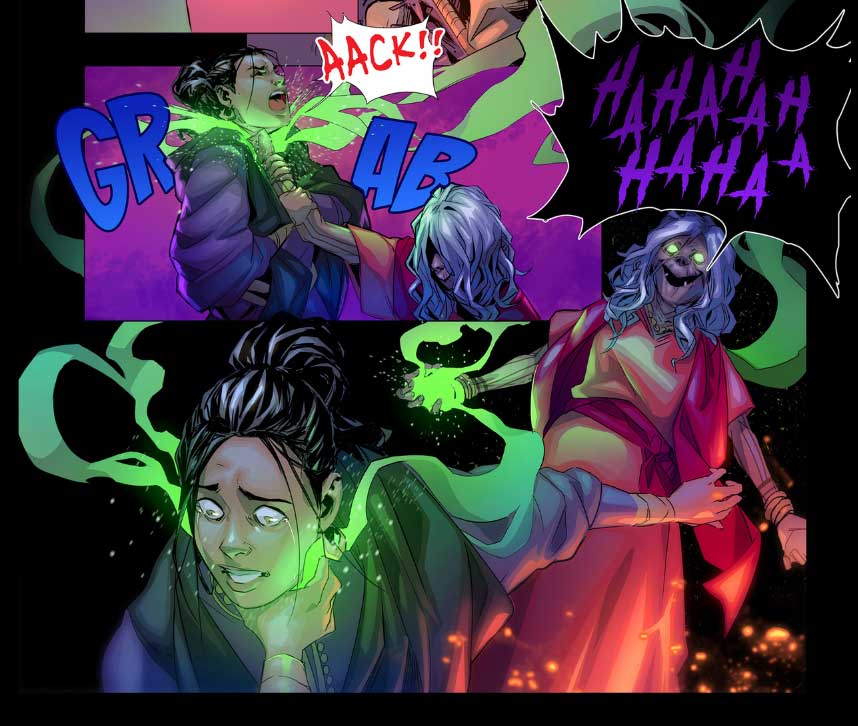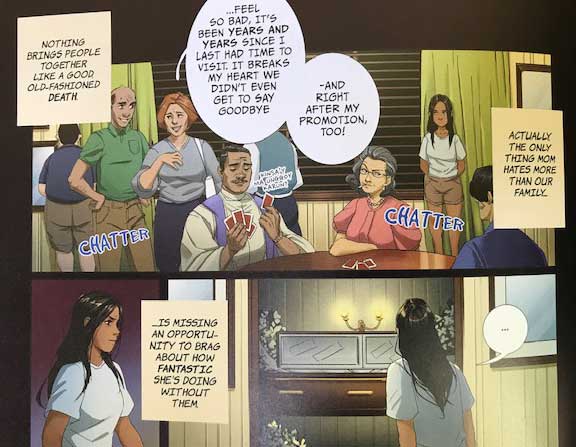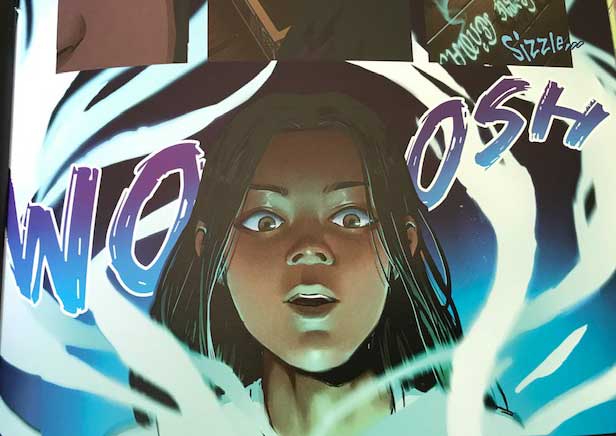|
Getting your Trinity Audio player ready...
|
“When shy, troubled Marisol (Mari) Reyes discovers a wooden mask at her great-grandmother’s wake, destiny beckons in the form of a giant sea serpent, an ancient battle, and a grim vision of the future.”
This is the official synopsis for The Mask of Haliya, the first release from the all-female/ all-Asian run Kwento Comics. The comic itself, however, is so much more.
The wonderful team put together on this first issue has created an excellent set up that leaves the door wide open to explore more than just the wonderful and confusing world of Philippine Mythologies. For me, the star of the show is artist Renoida Renovilla whose work makes each page turn an absolute joy! Although the art would not be so meaningful without the incredibly engaging story written by Kaitlyn Fajilan.

The Mask of Haliya is not just a story about a female heroine being thrust into the world of Philippine Mythologies, it is also a metaphor for the discovery of identity. Cebu (through Mari’s eyes) is a caricature of the complex lifelines and layers of the city. This is tough ground for the writer (Fajilan) to navigate. While it could be easy to focus on the very Filipino-American side of what constitutes the Filipino condition, she chooses subtle expressions and opinion to accentuate the differences of a common culture separated by the Pacific Ocean. This was a very important set-up. If it didn’t work, the violent awakening in the last few panels would not have been so impactful.
I passed along The Mask of Haliya to toughest critic I know – my 15-year-old Filipino-Canadian daughter. Our home and her upbringing are immersed with experiences and resources for her to explore her identity. Still, part of growing up is learning where you fit in the world or creating and contributing to your own space. I was interested to hear that, aside from loving the art, she could very much relate to the situational teen “mopiness” of Mari and felt that the Philippines (as presented in The Mask of Haliya) was definitely recognizable to her own experiences there. This isn’t always the case, which leads me to believe that Kwento Comics has created a powerful foundation that, through Mari, can truly relate others towards connecting Philippine cultures. Nobody among my circle of friends living in the Philippines has yet read The Mask of Haliya, but I imagine it would be a different experience for them. I’m sure they will recognize the Balikbayan characters and enjoy the story, but the exposition and exploration may feel slow. Filipino Komiks on this topic tend to move at a lightening pace and have the luxury of their main audience knowing the cultures and creatures, bypassing the needed set-up for an American reader.

Philippine Mythology aficionados reading this comic may nitpick over a couple of things that don’t necessarily stick to the strictures of written documentation. Mainly, the story takes place prominently in Cebu, yet Haliya was a ritual performed in Bicol and is assumed to have been the ancient Bicolano moon deity. This may be explained in future issues, although I will point out that cross pollination of ‘pantheons’ is not unheard of within Philippine Mythologies. I can recall the Tagalog creator deity, Bathala, appearing in Bisayan tales, and the Visayan deity of the afterlife, Sidapa, appearing as a Tagalog god of war in another. The history of the Philippines is a story of movement – movement of people, movement of language, and movement of culture. Other’s may note that Haliya was never mentioned in texts to have worn a mask. This is true, she didn’t. Haliya’s mask was an artistic invention, which I will expand on in a moment. Some other fan fiction has crept into the introductory back story of the moon-eating serpent, Bakunawa, but both the creator of Kwento, Cecilia Lim, and head writer, Kaitlyn Fajilan have acknowledged in interviews that these aspects are likely fan fiction. For Mari’s journey within the comic, I don’t think these nuances matter. I wholeheartedly believe these mythological, religious, and folkloric beings should be explored creatively to keep them alive and well in the minds of the people they belong to. The Mask of Haliya does this beautifully.
For those interested, the Haliya ritual is known to have been performed by women in ancient Bicol. This was documented by Fr. Castaño in 1896. In 1983 preeminent scholar Maria Lilia F. Realubit expanded on what this ritual would look like and suggested there were songs and poems regarding the Bicolano deities Gugurang and Haliya. In 1989, Bicolano artist Duddley Diaz (who studied under Realubit) made the artistic decision to give Haliya a mask. Other fanfiction presented the story of Haliya using a golden mask to hide her beauty or identity. Diaz mentioned that the mask was never intended to hide Haliya. The story of Bakunawa and the Seven Moons was first documented in Mga Sugilanong Karaan 1913 by Fernando Buyser. It has been re-written many times and a fanfiction rewriting interpreted that the seven moons represented seven lunar deities. Ultimately, Philippine Mythologies are confusing and complex. There are multiple sources, ideas, and interpretations that can easily make your head spin. How wonderful that Kwento Comics culminated so many years of historical creativity into a single story!

In closing, The Mask of Haliya is a highly recommended comic. You won’t be disappointed with the beautiful art and talented storytelling which, intentionally or intuitively, creates a metaphoric parallel for cultural awakening and could open an exploration of understanding for the unique challenges experienced by many Filipinos around the world.
I am very interested to see what folkloric beings and mythologies come into the life of Mari as she navigates her new world. You should join her on this journey.
You may order a hard copy through Kwento’s online shop: https://kwentocomics.com/web-store
Or a digital PDF through: https://globalcomix.com/c/the-mask-of-haliya
The Mask of Haliya #2 is now available.

Jordan Clark is a Canadian born descendant of Scottish immigrants living on the homelands of the Lekwungen speaking peoples. His interest in Philippine myth and folklore began in 2004. Finding it difficult to track down resources on the topic, he founded The Aswang Project in 2006. Shortly after, he embarked on a 5 year journey, along with producing partner Cheryl Anne del Rosario, to make the 2011 feature length documentary THE ASWANG PHENOMENON – an exploration of the aswang myth and its effects on Philippine society. In 2015 he directed “The Creatures of Philippine Mythology” web-series, which features 3 folkloric beings from the Philippines – the TIKBALANG, KAPRE and BAKUNAWA. Episodes are available to watch on YouTube. Jordan recently oversaw the editing for the English language release of Ferdinand Blumentritt’s DICCIONARIO MITOLÓGICO DE FILIPINAS (Dictionary of Philippine Mythology) and is working on two more releases with fellow creators scheduled for release later this year. When his nose isn’t in a book, he spends time with his amazing Filipina wife of 20 years and their smart and wonderful teenaged daughter.


